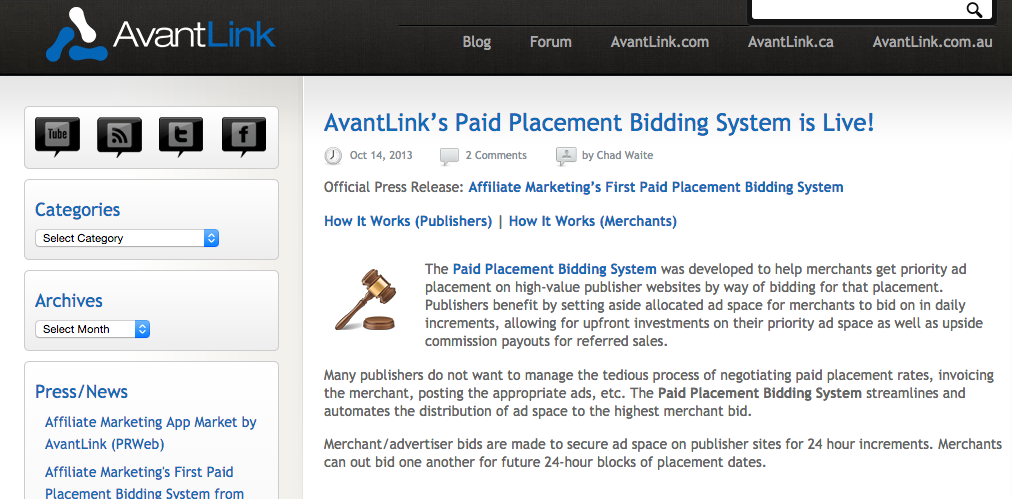Set aside some time in December to map out what 2015 will look like for your affiliate marketing channel. Many times, “thinking” becomes consumed by “doing,” which results in a reactive rather than a proactive strategy. Knowing this, over the next few weeks, devote some time to consider each of the action items listed below, and you’ll be in good shape to take charge of your affiliate marketing activities for 2015.
Commit to checking off all three items on this list before January 1, 2015.
1. Determine Affiliate Marketing Priorities for 2015
If your affiliate program is new, your top priority might be to grow your affiliate base. If this is the case, your 2015 strategies could include developing recruiting campaigns, building visibility at industry conferences and events, and evaluating paid placement opportunities to promote your affiliate program.
On the other hand, if your affiliate program is more mature, your top priority might be engaging your existing affiliates. The first step would be to determine what your current activation rate is. You can quickly gauge this by taking the number of affiliates that drove at least one click to your site in November, and divide that by the total number of affiliates in your program. If less than 30 percent, your 2015 strategies could include developing activation campaigns, prioritizing inactive affiliates, and conducting personal reach-outs to high-potential affiliates.
Or, let’s say you have a active base. Then perhaps it’s time to explore what new tools can be harnessed or developed. This year, 2014, was good for the industry in terms of new tools. AvantLink launched an ad marketplace, where retailers can bid on ad placements on affiliate sites. ShareASale launched a bookmarklet that enables affiliates to dynamically generate a tracking link to any page on a retailer’s site, provided an affiliate partnership is in place.
Or maybe there are tools out there that you haven’t incorporated into your affiliate program yet. Video continues to influence purchase decisions, and mobile has a growing share of ecommerce shoppers. Perhaps 2015 is the year your affiliate program expands into those channels. Research what new tools and technology are available to you, and work them into your 2015 strategy.
2. Set Quantitative Goals Based on Fact, Not Fiction
Sure, driving 300 percent growth in net revenue year-over-year would be a good goal to have. But is it realistic? For a new affiliate program, this could be feasible, and perhaps even conservative. However, for a mature program, 300 percent year-over-year growth might be excessive. Either way, you’re not going to know unless you understand what triggers are in play.
Once you know what your triggers are, you can map out when they will occur in 2015— based on 2014 performance. To start with, determine your key revenue drivers. Were there a few specific affiliates that drove most of your volume? If so, reach out to these affiliates and figure out how to ensure continued growth in 2015. Set up one-on-one meetings with them to go over 2014 performance and to plan out 2015 placements and budget. Perhaps you can start a customized, tiered incentive structure that pays if they hit a certain sales target.
Also look at your 2014 promotional calendar. Did sales spike every time you ran a particular promotion? If so, put that promotion on the calendar for 2015. The point is, make sure the data exists to support the kind of growth you are projecting for 2015.
3. Understand Impact of Affiliate Issues
The affiliate industry got its start in the late 1990s. It’s still young compared to other marketing and promotional tactics. It’s therefore still susceptible to innovation gaps, when technology develops faster than values, and new tools are created before processes are in place. These gaps are occurring right now. Consider the affiliate tax nexus legislation in many states. There is a gap here because sales tax laws were not created with online commerce in mind. (I addressed sales taxes and affiliate marketing earlier this year, in “Affiliate Marketing: 3 Legal Issues to Monitor in 2014.”)
Another example of a gap is the use of social media by brands and companies. In January 2015, Facebook will reportedly be shifting its algorithm so that promotional brand messaging will be limited in user news feeds. This shift could drive many brands to rely on affiliates for brand visibility on Facebook.
How to Keep Up?
The affiliate industry is continually in flux, with new technologies, new players, and new platforms. To keep up with it all, read the website of the Performance Marketing Association, which is a trade association that focuses on affiliate industry issues. Also consider attending industry conferences such as Affiliate Summit or AM Days.
Finally, do you have affiliate issues that you’d like to see covered here?, If so, please leave a comment below. One of my 2015 priorities is providing actionable content that is relevant to you, our ecommerce-merchant readers. Your feedback is definitely welcome.






